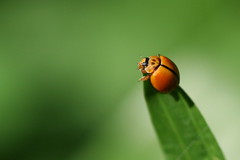Like me, you might be surprised to learn that such a strikingly good-looking spider could be native to the UK. The Ladybird spider (Eresus Sandaliatus) is one of Britain's rarest. So rare that for about 70 years it was thought to be extinct here until it was rediscovered in 1980. Careful conservation work has enabled the spider to grow from just a few individuals to over 1000, but more work is needed for this spider to come off the danger list.

By Viridiflavus (Own work) [CC-BY-SA-3.0 or GFDL], via Wikimedia Commons
The Spider and Harvestman Recording Scheme webite is tracking the whereabouts of this and other spiders. They report on the Ladybird Spider's preferences for south-facing sandy slopes and its four-year life cycle.
To really ensure its survival at least 20 sites where the spider can find a habitat are required. There is also, it has to be said, much still to learn about this spider, its requirements and role in the ecosystem.
The invertibrate conservation trust Buglife has an appeal raising funds for the development of habitats and further conservation work. It is an appeal well worth supporting.








